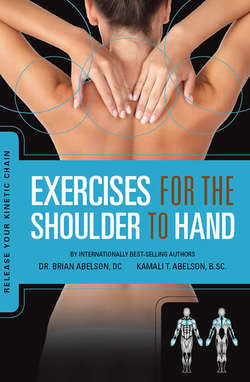Читать книгу Exercises for the Shoulder to Hand - Release Your Kinetic Chain - Dr. Brian James Abelson DC. - Страница 10
На сайте Литреса книга снята с продажи.
ОглавлениеThe Cumulative Injury Cycle
One of the best explanations of this ongoing injury process was first postulated by Dr. Michael Leahy, the developer of Active Release Techniques® (ART), in his Cumulative Injury Cycle1. The Cumulative Injury Cycle describes the major factors that lead to the initial injury, and explains how these injuries are perpetuated.
Whether the injury is the result of an acute trauma, repetitive motions (RSI injuries), or internal tissue pressure, the result is often the same.
Each of these factors leads to a proliferation of fibrous tissue (scar tissue). Once this fibrous tissue forms, muscles become weaker, friction increases, inflammation increases, oxygen transport and distribution diminishes, and a cycle of dysfunction is created.
What Can You Do About This?
Fortunately, there is a lot you can do to break this cycle of injury. The initial phase of an injury is known as the Inflammatory Phase. With acute injuries, R.I.C.E should be used within the first 48 to 72 hours.
R = Rest to prevent further damage. But not too long a rest as immobilization can result in scar formation. See Benefits of Rest - page 219 for more information.
I - Ice to reduce swelling, inflammation, and pain. See Cold Therapy - page 214 for more information.
C = Compression to provide support, reduce swelling, and reduce bleeding.
E = Elevate the injured area above the heart-level to reduce swelling and bleeding.
Without exercise, the probability of the collagen being laid down in a random manner and forming scar tissue is very high. Scar tissue is limited in its function, reduces movement, decreases circulation, and reduces sensation. The greater the amount of scar tissue, the greater the reduction in function of your muscles and other soft-tissues.
Injury Recovery
The second phase of injury recovery is known as Proliferative Phase and is characterized by the laying down of new collagen. This phase can start within two days of the injury and can last up to six weeks.
It is extremely important to be exercising during the Proliferative Phase as this will ensure that new collagen is laid down in the same fibre orientation as your muscle tissue, and that the new collagen does not inhibit relative motion between tissue layers.
The third and final stage of injury recovery is known as the Remodeling Phase and can last from three weeks to twelve months. During this phase the new collagen fibres remodel in proportion to the stress placed upon them. It is critical that you continue to exercise during this phase or your collagen fibres will never remodel fully.
So when injury strikes, do not pick and choose your exercises. We have designed our exercise routines to take you through these phases while addressing the needs of your entire kinetic chain. These programs will help you strengthen and heal – not just the initial area of pain, but also all the surrounding supportive soft-tissues in that structure’s kinetic chain.
Do these exercises when you find your hands and arms becoming stiff and restricted, to restore the mobility and function of your muscles and joints. Do the stretches whenever you are spending long hours in front of a computer keyboard! And do the strengthening exercises to resolve or prevent injuries, and improve your performance in all your activities.
During all injury recovery phases, soft-tissue manipulation such as Active Release Techniques or Massage Therapy can be very effective in reducing muscle spasms, reducing swelling, decreasing nerve compression, and reducing pain.
